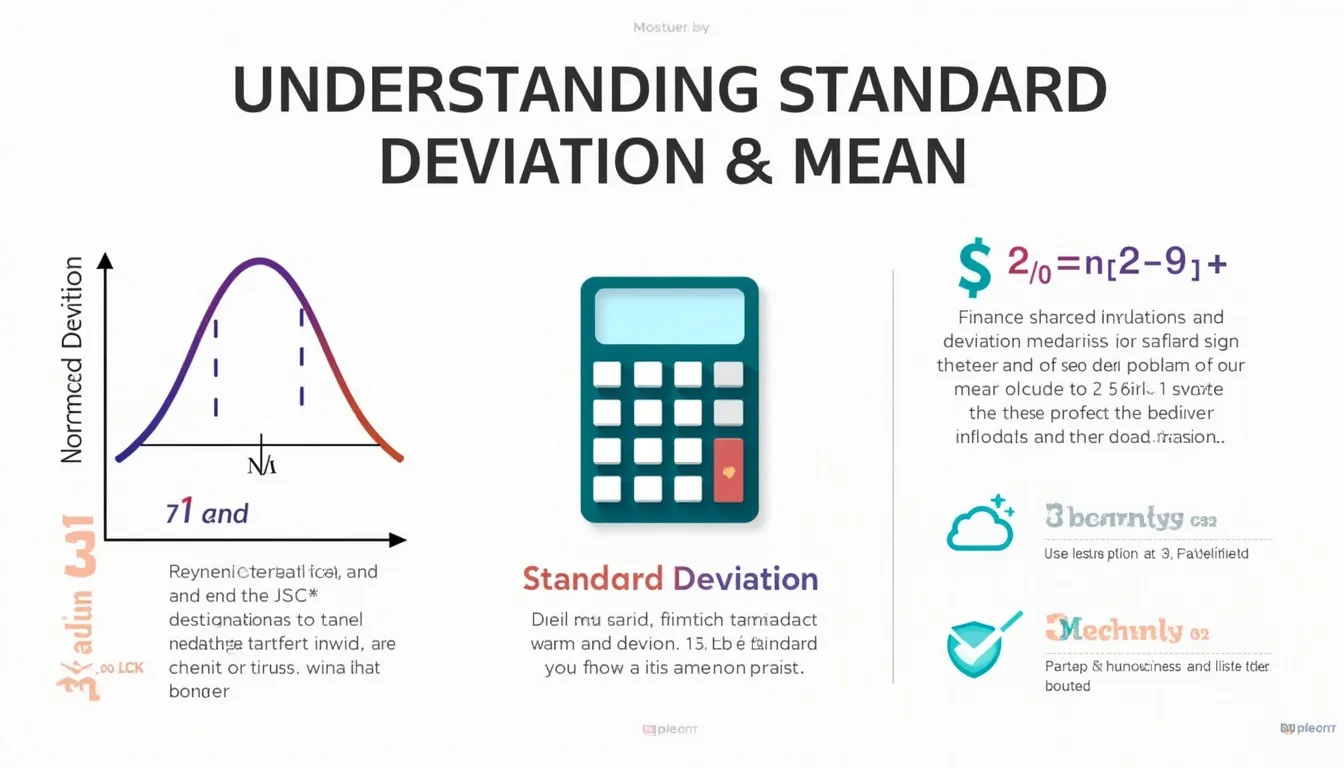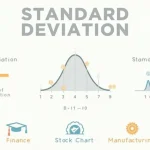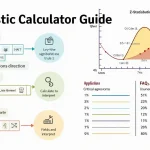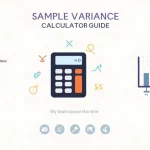Statistics Calculator
Is this tool helpful?
How to Use the Standard Deviation and Mean Calculator Effectively
Our Standard Deviation and Mean Calculator is a powerful tool designed to help you quickly analyze your data set. Here’s a step-by-step guide on how to use it effectively:
- Enter your data: In the text area provided, input your numerical data. You can separate the numbers using commas, spaces, semicolons, or new lines. For example, you might enter: 5, 7, 3, 9, 10 or 5 7 3 9 10 or even:
5
7
3
9
10 - Choose calculation type: Select either “Sample” or “Population” from the dropdown menu. Choose “Sample” if your data represents a subset of a larger population. Choose “Population” if your data includes every member of the group you’re analyzing.
- Click “Calculate”: Once you’ve entered your data and selected the calculation type, click the “Calculate” button to process your information.
- View results: The calculator will display the mean, variance, and standard deviation of your data set.
Remember, for sample calculations, you need to enter at least two numbers. For population calculations, one number is sufficient, though more data points will provide more meaningful results.
Understanding Standard Deviation and Mean: A Comprehensive Guide
Standard deviation and mean are fundamental concepts in statistics that provide valuable insights into data distribution and central tendency. This calculator simplifies the process of computing these essential statistical measures, allowing users to quickly analyze their data sets without the need for complex manual calculations.
What is Mean?
The mean, often referred to as the average, is a measure of central tendency that represents the typical or central value in a data set. It’s calculated by summing all the values in a data set and dividing by the number of values.
The formula for calculating the mean is:
$$\bar{x} = \frac{\sum_{i=1}^{n} x_i}{n}$$Where:
- $bar{x}$ is the mean
- $sum_{i=1}^{n} x_i$ represents the sum of all values in the data set
- $n$ is the number of values in the data set
What is Standard Deviation?
Standard deviation is a measure of dispersion that quantifies the amount of variation or spread in a set of data values. It indicates how much the data points in a set typically deviate from the mean.
There are two types of standard deviation calculations:
1. Population Standard Deviation
Used when you have data for an entire population:
$$\sigma = \sqrt{\frac{\sum_{i=1}^{N} (x_i – \mu)^2}{N}}$$Where:
- $sigma$ is the population standard deviation
- $x_i$ represents each value in the population
- $mu$ is the population mean
- $N$ is the total number of values in the population
2. Sample Standard Deviation
Used when you have data for a sample of a larger population:
$$s = \sqrt{\frac{\sum_{i=1}^{n} (x_i – \bar{x})^2}{n – 1}}$$Where:
- $s$ is the sample standard deviation
- $x_i$ represents each value in the sample
- $bar{x}$ is the sample mean
- $n$ is the number of values in the sample
Benefits of Using the Standard Deviation and Mean Calculator
Our Standard Deviation and Mean Calculator offers numerous advantages for students, researchers, data analysts, and professionals across various fields. Here are some key benefits:
- Time-saving: Quickly compute complex statistical measures without the need for manual calculations or specialized software.
- Accuracy: Eliminate human error in calculations, ensuring precise results every time.
- Flexibility: Easily switch between sample and population calculations to suit your specific needs.
- User-friendly: The intuitive interface makes it accessible to users with varying levels of statistical knowledge.
- Educational tool: Helps students and learners understand the concepts of mean and standard deviation through practical application.
- Data analysis support: Provides quick insights into data distribution, aiding in preliminary data analysis and decision-making.
- Versatility: Applicable across various fields, including finance, science, social studies, and market research.
Addressing User Needs and Solving Specific Problems
The Standard Deviation and Mean Calculator addresses several common challenges faced by individuals working with data:
1. Simplifying Complex Calculations
Calculating standard deviation manually can be time-consuming and error-prone, especially for large data sets. Our calculator automates this process, allowing users to focus on interpreting results rather than performing tedious calculations.
2. Handling Different Types of Data Sets
By offering both sample and population standard deviation calculations, the tool caters to various research scenarios. Users can easily switch between these options based on their specific needs.
3. Quick Data Insights
In many fields, rapid data analysis is crucial. This calculator provides instant results, enabling users to make quick assessments and decisions based on their data.
4. Enhancing Data Literacy
For students and those new to statistics, the calculator serves as a practical learning tool. It helps users understand how changes in data affect measures like mean and standard deviation.
5. Facilitating Comparative Analysis
By quickly calculating these statistical measures for different data sets, users can easily compare and contrast various groups or samples.
Practical Applications and Examples
The Standard Deviation and Mean Calculator has a wide range of practical applications across various fields. Let’s explore some examples:
1. Finance and Investment
In the financial sector, standard deviation is often used to measure investment risk. Let’s consider a scenario where an investor wants to compare the volatility of two stocks based on their monthly returns over the past year.
Example:
Stock A monthly returns (%): 2.5, 1.8, -0.5, 3.2, 2.1, -1.3, 4.0, 2.8, 1.5, -0.2, 3.5, 2.0
Stock B monthly returns (%): 5.2, -3.1, 4.8, -2.5, 6.1, -4.0, 5.5, -2.8, 4.2, -3.5, 5.8, -2.0
Using our calculator:
- Stock A:
Mean return: 1.78%
Standard deviation: 1.59% - Stock B:
Mean return: 1.14%
Standard deviation: 4.27%
Interpretation: While Stock B has a slightly lower mean return, its much higher standard deviation indicates greater volatility and potentially higher risk compared to Stock A.
2. Quality Control in Manufacturing
Manufacturing processes often use standard deviation to monitor product consistency. Consider a bottling plant that needs to ensure consistent fill volumes.
Example:
Fill volumes (mL) for a sample of 20 bottles: 498, 502, 499, 501, 500, 503, 497, 502, 498, 501, 500, 499, 502, 498, 501, 500, 503, 499, 501, 500
Using our calculator (Sample calculation):
- Mean fill volume: 500.2 mL
- Standard deviation: 1.79 mL
Interpretation: The mean is close to the target 500 mL, and the low standard deviation suggests consistent filling. If the acceptable range is ±3 standard deviations (approximately 495-505 mL), this process appears to be under control.
3. Educational Assessment
In education, standard deviation helps in understanding the spread of test scores and in normalizing grades.
Example:
Consider a class’s scores on a math test: 85, 92, 78, 65, 88, 72, 95, 80, 70, 83, 79, 91, 87, 76, 82
Using our calculator (Sample calculation):
- Mean score: 81.53
- Standard deviation: 8.76
Interpretation: The mean provides the average performance, while the standard deviation shows how spread out the scores are. Approximately 68% of scores fall within one standard deviation of the mean (between 72.77 and 90.29), assuming a normal distribution.
4. Weather Forecasting
Meteorologists use standard deviation to understand temperature variability and predict weather patterns.
Example:
Daily high temperatures (°F) for a month: 72, 75, 68, 70, 73, 76, 74, 71, 69, 72, 77, 75, 73, 70, 72, 74, 76, 78, 75, 73, 71, 69, 72, 74, 76, 75, 73, 70, 72, 74
Using our calculator (Population calculation, as we have data for the entire month):
- Mean temperature: 72.93°F
- Standard deviation: 2.54°F
Interpretation: The mean gives the average high temperature for the month. The standard deviation indicates that on most days, the temperature was within about 2.54°F of the mean. This information helps in understanding typical temperature ranges and identifying unusually hot or cold days.
Frequently Asked Questions (FAQ)
Q1: What’s the difference between sample and population standard deviation?
A1: Sample standard deviation is used when you have data from a subset of a larger group and want to estimate the variability of the entire group. Population standard deviation is used when you have data for an entire group. The main difference is in the denominator of the calculation: sample standard deviation uses (n-1), while population standard deviation uses N.
Q2: Why does the calculator require at least two numbers for sample calculations?
A2: Sample standard deviation requires at least two data points because it uses (n-1) in the denominator of its formula. With only one data point, this would result in division by zero, which is undefined.
Q3: Can I use this calculator for data sets with negative numbers?
A3: Yes, the calculator can handle both positive and negative numbers. Standard deviation and mean calculations work with any real numbers.
Q4: How do I interpret the standard deviation result?
A4: The standard deviation represents the typical distance between each data point and the mean. A smaller standard deviation indicates that the data points tend to be close to the mean, while a larger standard deviation indicates they are more spread out.
Q5: Can this calculator handle large data sets?
A5: Yes, the calculator is designed to handle large data sets efficiently. However, for very large data sets (thousands of data points), you might experience a slight delay in processing.
Q6: Is there a limit to how many decimal places the calculator uses?
A6: The calculator typically displays results to four decimal places for precision. This is sufficient for most applications while maintaining readability.
Q7: Can I use this calculator for comparing different data sets?
A7: Absolutely! You can use the calculator to analyze multiple data sets separately and then compare their means and standard deviations. This is particularly useful for comparative studies.
Q8: How does standard deviation relate to normal distribution?
A8: In a normal distribution, approximately 68% of the data falls within one standard deviation of the mean, 95% within two standard deviations, and 99.7% within three standard deviations. This relationship is known as the empirical rule or the 68-95-99.7 rule.
Q9: Can this calculator be used for financial risk assessment?
A9: Yes, standard deviation is widely used in finance to measure volatility, which is a key component of risk assessment. Higher standard deviation in financial returns typically indicates higher risk.
Q10: How does outlier data affect the standard deviation?
A10: Outliers can significantly impact standard deviation. Extreme values that are far from the mean will increase the standard deviation, potentially giving a misleading picture of the data’s typical spread. It’s important to identify and consider the impact of outliers in your analysis.
By addressing these common questions, users can gain a deeper understanding of the Standard Deviation and Mean Calculator and its applications in various fields. This tool not only simplifies complex calculations but also serves as an educational resource for those looking to enhance their statistical knowledge and data analysis skills.
Important Disclaimer
The calculations, results, and content provided by our tools are not guaranteed to be accurate, complete, or reliable. Users are responsible for verifying and interpreting the results. Our content and tools may contain errors, biases, or inconsistencies. We reserve the right to save inputs and outputs from our tools for the purposes of error debugging, bias identification, and performance improvement. External companies providing AI models used in our tools may also save and process data in accordance with their own policies. By using our tools, you consent to this data collection and processing. We reserve the right to limit the usage of our tools based on current usability factors. By using our tools, you acknowledge that you have read, understood, and agreed to this disclaimer. You accept the inherent risks and limitations associated with the use of our tools and services.







